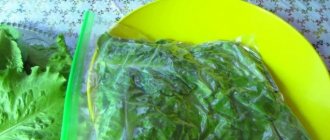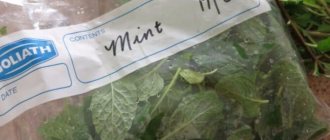Everyone knows that green leafy vegetables have a short shelf life compared to root vegetables. Many housewives want to know how to preserve lettuce leaves for the winter at home, because with the onset of cold weather they want to prolong the enjoyment of the taste of juicy, vitamin-rich greens.
The methods below are suitable for storing different types of lettuce (iceberg, romaine, corn, frisse, spinach, chard and others)
In this article we will talk about how to properly prepare the product for long-term storage, as well as several popular methods that allow you to prepare lettuce leaves for the winter and be able to use them at any time of the year.
Know the varieties of leaf lettuce
All types of salads are healthy and in demand in proper nutrition. They are low-calorie, rich in minerals, fiber, vitamins, accelerate metabolic processes, help lose weight, and stimulate intestinal function.
I will name the types that are well stored:
- lettuce (coral and leaf);
- iceberg;
- Batavia;
- romaine lettuce;
- oakleaf (oakleaf);
- butterhead;
- curly (frise, exariol, endive).
On the Rosstandart website there is a current GOST 33985-2016. The document contains a detailed description of the product and establishes recommendations for transportation and storage of all botanical types of salads.
GOST 33985-2016 on the Rosstandart website
Pickling
Try pickling lettuce and storing it in the refrigerator for a long time.
- Place 3-4 cloves of garlic and a stalk of celery cut into pieces on the bottom of the saucepan.
- Place pre-washed leaves one at a time.
- Top them with sprigs of celery and dill.
- Prepare a marinade from 1 liter of water, 2 large spoons of sugar, 1 spoon of salt and a small spoon of citric acid.
- Pour hot marinade over the leaves and place pressure on top.
When the water has cooled, the pickled salad is placed in the refrigerator. If there is not enough space on the refrigerator shelves, you can store the product in the cellar.
Store salad fresh: 4 ways
The life of leafy greens when cut is short: they quickly wilt, wither, and lose their juiciness and aroma. Leaf lettuce, compared to parsley, celery and other herbs, has a larger leaf surface, a delicate structure and the shortest shelf life.
The greens will remain unchanged longer if you use folk tricks. I’ll tell you in detail about all the proven methods. How to store lettuce leaves in the refrigerator:
| Method 1. In a cup of water Water is used to maintain hydration balance. Leaves filled with moisture do not fade and remain juicy:
Shelf life - the salad will remain fresh in the refrigerator - 4-7 days, on a cool windowsill - 2-3 days | |
| Method 2. In a container You need a plastic container with a lid or an enamel bowl:
There must be room for air under the lid - this is a must. When using a bowl, the lid will be replaced by polyethylene with small holes for “breathing” | |
| Method 3. In the package Option - for washed and unwashed greens. An important point: the leaves should be slightly damp:
Shelf life : Leaves will remain fresh on the bottom shelf of the refrigerator for 7–10 days. It is more convenient to use a bag with a slider or Velcro fastener | |
| Method 4. Substrate Food grade foam maintains microclimate and is used for storing vegetables:
Shelf life : 5–7 days |
You can extend the shelf life of greens up to 30 days with the help of silver. It is known that this metal blocks the development of putrefactive microorganisms. A silver item is placed in a container with greens and covered with a lid.
Storage conditions for lettuce leaves
Fresh lettuce leaves contain a lot of moisture, they are juicy and have a delicate taste. Therefore, when opened, they wither very quickly. If the room is hot, they will wilt within 30-60 minutes. Therefore, they are never left without cover. Usually a film or bag is used.
Storage conditions:
- low temperatures, optimal mode from +1 to +10 degrees;
- high humidity, about 70-90%;
- the presence of containers or wrappers.
It is advisable to store lettuce leaves in a cool, dark place. It is important to protect from moisture evaporation; however, it should not be hermetically sealed. We recommend placing them in containers or bags with holes. Shelf life is on average one week.
Do you grow lettuce for the winter?
Not really
Store salad for a long time: 3 ways
Leaf lettuce can be saved until next season. The vitamin composition will suffer a little, but you will get an excellent side dish, filling for pies, semi-finished product for sauces, seasoning soups, salads.
My favorite recipes:
| Photo | Recipe Description |
Recipe 1. Frying in oil
The canned product is served with meat and vegetable dishes and included in salads | |
| Recipe 2. Marinating with spices Adding spices will make the salad a flavorful snack:
Shelf life - at +3...+7 °C the snack is stored for 1-2 months. Served with mayonnaise, balsamic, vegetable oil, boiled vegetables | |
| Recipe 3. Freezing I keep greens in the freezer all winter. But after normal freezing, they will turn into an unsightly mush. I have a recipe for vegetable puree:
If desired, add your favorite spices and vegetables. Used as a vitamin supplement in side dishes, soups, sauces |
Container for storing lettuce leaves
Allowed to be stored in different containers, be sure to cover. If a bag is used, it is pierced. Plastic containers must have windows in the lids. Lettuce leaves can be lightly irrigated with water. But it’s better to pour a little liquid on the bottom and install it vertically. Polystyrene substrates are excellent. They are used for packaging various products in supermarkets.
How to pack lettuce leaves on a tray:
- Moisten the bottom or pour a little water. A thin layer should barely cover the surface.
- Place the lettuce bunches vertically. If they are tied, remove the threads. We recommend cutting off the dried edges of the stems.
- Wrap the top with cling film, straight from the roll. Do not wrinkle it.
- Make punctures with a toothpick, don’t skimp.
- Place in the refrigerator. Or just take it to a cool place.
The trays are easy to use. The condition of the leaves can be seen through the film. It is easy to lift and remove yellowing, flaccid specimens. Or simply open, take the required amount, and return the wrapper to its place.
What can be stored in:
- polystyrene trays;
- containers with windows/valves in the lid;
- plastic bags, cling film.
What should not be stored in:
- sealed jars;
- containers made of metal, wood;
- paper.
Ways to store lettuce for the winter
Extend shelf life
The success of storage does not always depend on the method chosen. The main thing is the condition of the product. For example, I have beds with herbs, so I have a high-quality harvest, the freshness of which is beyond doubt. This product always lasts longer. If you are a city dweller and use products from supermarkets, then learn to choose.
Buy according to the rules
When buying in a store, it is difficult to determine the collection time. Before storing in the refrigerator, check the condition of the lettuce; the shelf life depends on this. Some tips on how to choose a good salad:
- buy greens only in the head;
- consider the condition of the leaves: they should be intact, without kinks/dents;
- check the juiciness of the stem: it breaks with a slight crunch, juice appears on the cut;
- in a pot is the best option, the plant is in its natural environment and continues to grow.
For long-term storage, choose lettuce leaves in a head, without damage
To wash or not to wash?
There is no affirmative answer. Double opinion with a value of 50/50%:
- supporters of storing pure greens claim that their beneficial properties and appearance are successfully preserved;
- oppositionists insist on the opposite.
But I know that to better preserve the vitamin composition, there is no need to wash the greens. In its natural state there will be no negative changes. Leaves should be washed immediately before eating.
Before storing, you can wash the leaves or not, this does not have much effect on the condition of the greenery. Photo: vsepodomu.ru
Preparatory stage and storage in the refrigerator
In order for harvested vegetables to please you with their appearance and taste, it is necessary to use a high-quality starting product.
If you grow a salad crop in your own garden, harvest in the morning in dry weather, because excess moisture will lead to rapid spoilage of the greens. The plant is dug up along with the rhizome and placed vertically in pre-prepared ventilated boxes.
Due to its delicate structure, lettuce does not tolerate transportation well, and if storage rules are not followed, it can lose its original appearance in just a few hours.
Remove lettuce from the garden in dry weather
When buying greens at the market or in a store, give preference to a plant with roots, preferably with the remains of soil on them . The leaves should be juicy and elastic, without the slightest damage or signs of spoilage, but not overripe. Before buying, taste the salad: an overgrown vegetable almost always tastes bitter and the preparation from it turns out to be tasteless.
Give preference to medium-sized leaves, even if large rosettes of lettuce seem more attractive.
If immediately after harvesting or purchasing you do not have the opportunity to store the salad for long-term storage, it can be stored in the refrigerator . To do this you need to know the following tricks:
- to keep lettuce leaves fresh for about 2 days , you need to put them in the vegetable compartment, after wrapping them in a damp towel;
- greens will remain on the vegetable shelf of the refrigerator for 1 week if you wrap it in a paper napkin and put a silver object (for example, a spoon) inside the package;
- If you need to preserve the salad for up to 14 days , keep it in the refrigerator in glass or plastic airtight containers. Place a paper napkin on the bottom of the container, lay out a layer of greens, cover with paper on top and tightly close the contents with a lid.
In the refrigerator, the salad can stay fresh for up to 2 weeks.
Reanimate the salad
In case of wilting of greenery, I have a restoration technique. I’ll tell you about a universal method that is acceptable not only for all types of salad, but also for all types of spicy greens, including capricious cilantro:
- place the leaves in a bowl;
- fill with ice water;
- leave for 2 hours under the lid - the green mass will be saturated with moisture.
- you will notice the result within an hour - if the leaves are completely straightened and become elastic, then you can pull them out;
- remove lettuce leaves, shake;
- Place on a table lined with a waffle or paper towel to dry.
To restore the freshness of the leaves, do not break off the root tail, make a cut with a sharp knife to allow moisture to enter.
The reanimated lettuce can and even should be used immediately. If you plan to store it, use a container and put it in the refrigerator. But it needs to be implemented within two days.
Preparation for storage
Leaf lettuce can be grown in the garden, or it can be purchased. But regardless of whether it was purchased or grown at home, it is important not to forget about several factors that will affect its further storage:
- If the plants are from a summer cottage, you should remember that if there is moisture , the leaves will begin to deteriorate faster. For this reason, it is advisable to harvest the plants on a clear day, when the dew has evaporated.
- The plant must be removed from the ground along with the roots , and then placed in a wooden container with the roots down.
- Leaves will be stored for a long time if they are not damaged by insects , do not show signs of disease, have an elastic structure and a bright green color.
- You should also buy lettuce with roots , so it will last longer.
- The leaves are chosen fresh, without signs of wilting.
How to freeze lettuce leaves
Many housewives are afraid to freeze lettuce leaves because of their fragility and rapid spoilage. However, this greenery tolerates the freezer well, although it loses its aesthetic properties.
Freezing is one of the easiest ways to preserve vitamins and other beneficial components of greens as much as possible. The salad can be frozen either whole or chopped. To preserve the rich color and aroma of the leaves, you can place them in hot water for 1–2 minutes and then in cold water for 30 seconds.
Before the freezing procedure, you need to tear the greens with your hands or grind them into a paste. When crushed after freezing, it is ideal for making smoothies. It is not recommended to cut the salad with scissors or a metal knife, as in this case it loses its taste.
Stages of freezing lettuce leaves:
- Rinse greens with cool water.
- Remove excess moisture. Allow to dry thoroughly.
- Transfer the leaves to a plastic container or plastic bag.
- Close the container tightly and place it in the freezer.
Frozen salad in winter can be added to drinks, first and second courses.
Second method:
- First you need to finely chop the lettuce.
- Then put it into molds.
- Next, pour cooled boiled water.
- Place in the freezer.
- Place the resulting ice cubes with herbs into a bag.
The shelf life of frozen greens is no more than a year. Lettuce cubes are ideal for adding to soup in winter or fall.
Important: you cannot freeze the salad more than once.
Cooking features
- You need to collect the salad early in the morning, but after the dew has disappeared, otherwise it will spoil very quickly.
- Try not to overgrow the salad, as the large leaves of this plant have a pronounced bitter taste.
- When harvesting lettuce, the bushes are pulled out by the roots and placed vertically in a box (root down).
- Before cooking, the lettuce leaves are separated from the root, separated one at a time to make sure there are no slugs hiding between them, then washed and dried. Lettuce leaves must be dried thoroughly, since drops of water remaining on them can spoil not only the taste of the product, but also its safety. For better drying, the leaves are laid out on a towel or flannel, wrapped in cloth and lightly kneaded with your hands.
- The French believe that leaf lettuce becomes less tasty when it comes into contact with metal, so they often tear it rather than cut it before adding it to food. However, for winter preparations it can be either torn or cut. This is due to the fact that using a knife significantly speeds up the process of chopping the product. However, if you are harvesting a small amount of greens, the lettuce leaves can be torn rather than cut.
It is advisable to prepare salad leaves for the winter immediately after harvesting. Every day they lose 20-25% of the nutrients they contain. The sooner you utilize your harvest, the more useful your harvest will be.
Lettuce cubes with dill and parsley
This version of the preparation is well suited for further use in sauces and soups. One cube is enough for the dish to acquire a rich green aroma.
Making a green salad using this recipe is very easy. To do this you need:
- Take a large bunch of lettuce leaves, one bunch of dill and parsley, rinse everything and grind in a blender bowl.
- To make the greens release more juice, you can add a little salt.
- Place the finished mixture in an ice tray, and after hardening, pour the cubes into a bag.
In this form, the salad can be stored for up to one year.
By putting into practice the secrets of experienced chefs, you can preserve this healthy, vitamin-rich product for a long time and enjoy it throughout the year.
Source
Drying leaves
A simple method of storing greens is drying. Dehydration is carried out both in special devices and in the open air.
Process:
- To begin with, select a quality product.
- Roots and rough branches are cut off from suitable leaves.
- Rinse the greens thoroughly under running water.
- Drain the liquid and place the leaves on a paper or cloth towel until completely dry.
- The next step is drying. If there is no dehydrator, use the oven or place the vegetables on a flat surface, cover with gauze and leave them in the shade with access to fresh air.
- After drying, it is recommended to store it in airtight glass containers or paper bags.
It is better to take young, tender leaves. They will retain the taste without adding bitterness.











